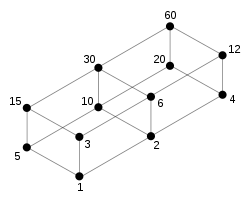Almost perfect number

In mathematics, an almost perfect number (sometimes also called slightly defective or least deficient number) is a natural number n such that the sum of all divisors of n (the sum-of-divisors function σ(n)) is equal to 2n − 1, the sum of all proper divisors of n, s(n) = σ(n) − n, then being equal to n − 1. The only known almost perfect numbers are powers of 2 with non-negative exponents (sequence A000079 in the OEIS). Therefore the only known odd almost perfect number is 20 = 1, and the only known even almost perfect numbers are those of the form 2k for some positive number k; however, it has not been shown that all almost perfect numbers are of this form. It is known that an odd almost perfect number greater than 1 would have at least 6 prime factors.[1][2]
If m is an odd almost perfect number then m(2m − 1) is a Descartes number.[3] Moreover if a and b are positive odd integers such that and such that 4m − a and 4m + b are both primes, then m(4m − a)(4m + b) would be an odd weird number.[4]
References
- ↑ Kishore, Masao (1978). "Odd integers N with five distinct prime factors for which 2−10−12 < σ(N)/N < 2+10−12" (PDF). Mathematics of Computation. 32: 303–309. doi:10.2307/2006281. ISSN 0025-5718. MR 0485658. Zbl 0376.10005.
- ↑ Kishore, Masao (1981). "On odd perfect, quasiperfect, and odd almost perfect numbers". Mathematics of Computation. 36: 583–586. doi:10.2307/2007662. ISSN 0025-5718. Zbl 0472.10007.
- ↑ Banks, William D.; Güloğlu, Ahmet M.; Nevans, C. Wesley; Saidak, Filip (2008). "Descartes numbers". In De Koninck, Jean-Marie; Granville, Andrew; Luca, Florian. Anatomy of integers. Based on the CRM workshop, Montreal, Canada, March 13–17, 2006. CRM Proceedings and Lecture Notes. 46. Providence, RI: American Mathematical Society. pp. 167–173. ISBN 978-0-8218-4406-9. Zbl 1186.11004.
- ↑ Melfi, Giuseppe (2015). "On the conditional infiniteness of primitive weird numbers". Journal of Number Theory. 147: 508–514. doi:10.1016/j.jnt.2014.07.024.
Additional reading
- Guy, R. K. (1994). "Almost Perfect, Quasi-Perfect, Pseudoperfect, Harmonic, Weird, Multiperfect and Hyperperfect Numbers". Unsolved Problems in Number Theory (2nd ed.). New York: Springer-Verlag. pp. 16, 45–53.
- Sándor, József; Mitrinović, Dragoslav S.; Crstici, Borislav, eds. (2006). Handbook of number theory I. Dordrecht: Springer-Verlag. p. 110. ISBN 1-4020-4215-9. Zbl 1151.11300.
- Sándor, Jozsef; Crstici, Borislav, eds. (2004). Handbook of number theory II. Dordrecht: Kluwer Academic. pp. 37–38. ISBN 1-4020-2546-7. Zbl 1079.11001.
- Singh, S. (1997). Fermat's Enigma: The Epic Quest to Solve the World's Greatest Mathematical Problem. New York: Walker. p. 13.
